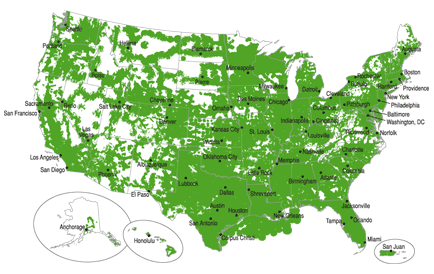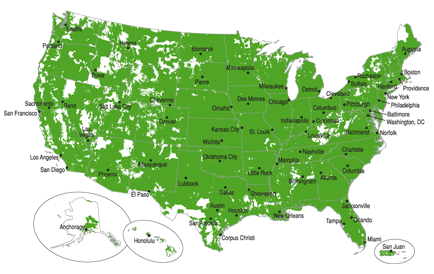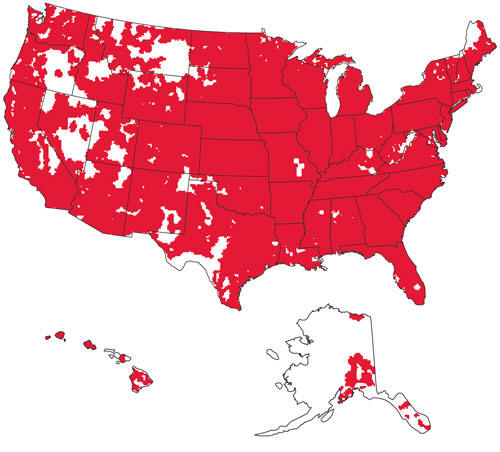Coverage
and Roaming
Coverage
Coverage of prepaid providers varies
greatly and depends on both the quality of the host carrier's native coverage as
well as the ability to roam onto other carriers using the same technology (GSM
or CDMA). Verizon has the best nationwide coverage by far, followed by AT&T,
Sprint, T-Mobile, and Nextel (now part of Sprint). It's important to distinguish
between native coverage and roaming coverage, because some prepaid carriers
don't allow roaming, even at extra cost, so coverage on these carriers will be
non-existent if you go out of their relatively small native coverage area. Some
prepaid carriers do allow roaming but charge significantly higher rates for it.
Check the coverage maps at the Verizon,
AT&T, Sprint, and T-Mobile web sites to get an idea of the carrier's native and
roaming coverage. Be sure to look at the prepaid map which often has much more
limited coverage than the same carrier's postpaid map. Some of the prepaid
carriers have their own coverage maps as well, i.e. Virgin Mobile has the Sprint
map with all the roaming coverage removed as shown below. Also see each
January's Consumer Reports where they report on the different wireless carriers
and poll over 50,000 subscribers across the country (Verizon and Alltel are
consistently the top rated carriers (and now Alltel is part of Verizon); this is
one case when an advertiser's catch phrase, "It's the Network," has some
validity.
Roaming
Most MVNO prepaid plans allow
roaming off the primary network though sometimes there are significant extra
charges for roaming. You definitely want to avoid Virgin Mobile which doesn't
allow off-Sprint roaming, which results in
very limited coverage outside urban areas or freeway corridors. For example,
look at the Sprint coverage map (below left) versus the Virgin Mobile coverage map for
the same area (below right). The green area is native Sprint coverage. The gray
area is roaming coverage, primarily onto Verizon, but also onto some smaller
CDMA carriers. The white area is no coverage. As you can see, there are vast
roaming areas with Sprint postpaid where you'll get no coverage at all with
Virgin Mobile (though calls to 911 may work). Virgin Mobile's statement on roaming is:
"No roaming means no
roaming charges," which is one of the most
clueless statements I've seen on any prepaid web site! There do not appear to be
any MVNOs on the Sprint network that allow roaming, even at extra cost. One of
the most amusing things I read on Usenet was from someone that insisted that the
lack of coverage on Cingular wasn't a problem for him because he simply planned
all of his travel routes, and chose his vacation destinations, based on
the availability of coverage from Cingular!
Sprint Postpaid
Coverage Versus Coverage on Sprint's MVNO Virgin Mobile
| Sprint Postpaid Coverage in
Sacramento to Reno Tahoe |
|
Virgin Mobile
Coverage in Sacramento to Reno Tahoe |
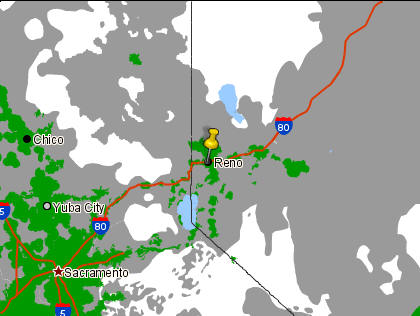 |
|
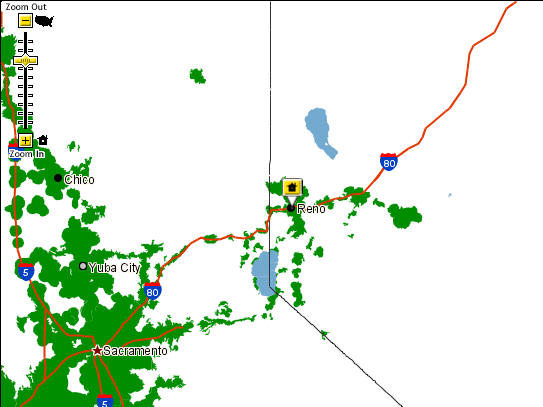 |
| Green is Sprint native coverage.
Gray is roaming coverage, mainly on Verizon, which is available to
Sprint postpaid users, but not to Jitterbug or Virgin Mobile users. |
|
Green is Sprint Native
Coverage, available to Virgin Mobile users. White is
no coverage. Vast areas of roaming coverage, that Sprint's regular
postpaid customers can use, are not available to Virgin Mobile
users. |
With any of the MVNOs that charge extra
for roaming, you want to be sure that you're not going to be spending a lot
of time in roaming areas, i.e. make sure your home and work locations are
not roaming areas. Paying for occasional
roaming isn't a big deal, just don't get into gab-fests.
Coverage Map Websites
For detailed coverage maps click on the
hyperlink (blue underlined name of the carrier). Take this information with
several grains of salt as coverage changes more often than the maps are updated.
Some coverage maps are very accurate, like T-Mobile's, which shows coverage down
to the street level, emanating from each tower, and they do seem to keep it up
to date (recently they added coverage to my neighborhood with a new tower, and
it showed up even before the tower was on line). Some maps are less detailed,
like Verizon's. Special coverage isn't shown, i.e. Verizon is the only carrier
with coverage in the Washington D.C. Metro underground sections.
PagePlus
The maps on the PagePlus web site are
very out of date. PagePlus did recently
issue a statement that they have added the former Alltel areas as non-roaming
coverage. See the announcement at
http://www.pagepluscellular.com/news/COVERAGE.PDF. I got a message from
a PagePlus executive on September 11th 2009 saying that the new coverage maps
would be up in a couple of weeks. Until they update their maps, use the Verizon
InPulse coverage map as a rough guide to PagePlus non-roaming coverage.
The coverage is excellent, but there is extra-cost off-network roaming in rural areas. For CDMA phones on
PagePlus look at the roaming indicator ( means you're
(it's counter-intuitive)), while a solid roaming indicator means that it's
extra cost roaming. If you place a call while roaming you'll need to enter the
number twice, this is the indication that you're roaming, but when receiving
calls while roaming you need to check your handset to see the status. Before you
sign up with PagePlus be certain that your home area, and places you frequently
visit, are not roaming areas.
If you go to
http://www.verizonwireless.com/b2c/CoverageLocatorController and tick
the circle for "Enhanced Services" the dark green is native Verizon coverage. If
you're not in the dark green area then you'll likely be paying roaming charges,
which are very high. In the past, the PagePlus map looked pretty close to the Verizon
Enhanced Services
coverage map (not the Verizon InPulse map). Verizon has native coverage in most mid to large size urban areas.
|
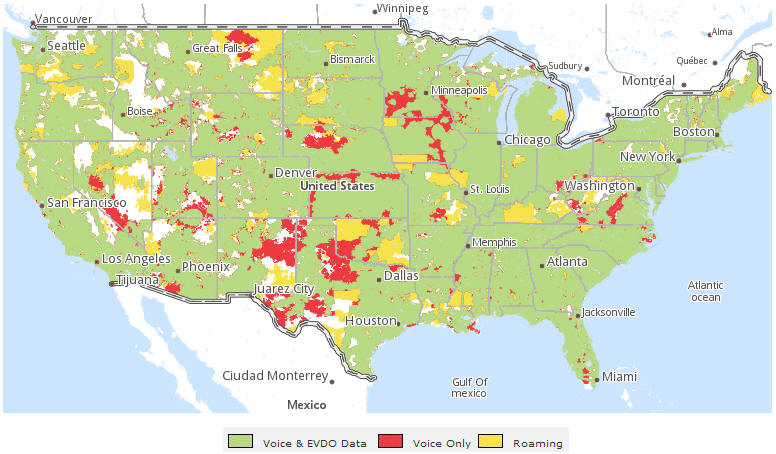 |
|
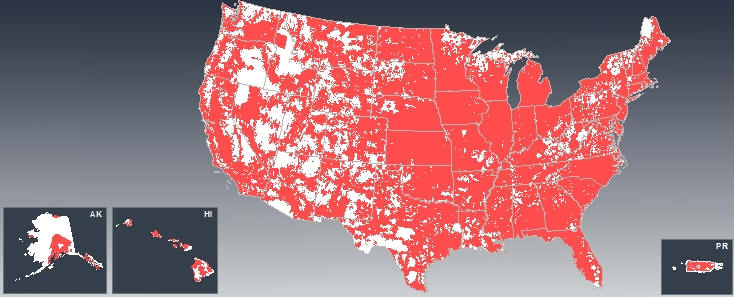 |
| PagePlus (Verizon network) |
|
Verizon Postpaid Service
Red is Included Coverage
(native or roaming), white is no coverage. |
Virgin
Mobile
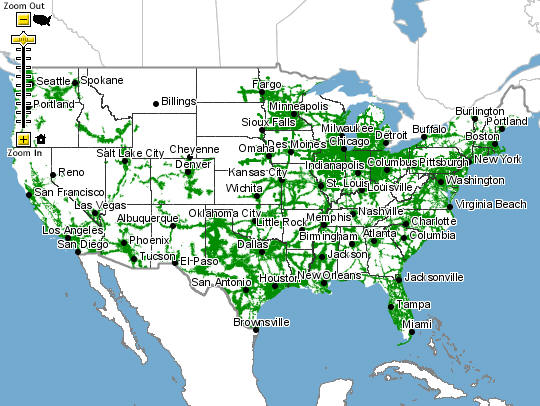 |
|
 |
| Virgin Mobile Prepaid (on
Sprint)
Green is coverage, White is no coverage.
Roaming is not available. Coverage is okay in most cities, but don't
venture out to any national parks, or out into the heartland. |
|
Sprint Postpaid Service
Green is native coverage,
Gray is roaming coverage. White is no coverage. Note the vast amount
of roaming you get with Sprint postpaid coverage that doesn't exist
with Virgin Mobile. |
T-Mobile Prepaid
T-Mobile's prepaid coverage has
improved, and it now includes extensive roaming. Postpaid adds coverage mainly
in Mexico. The downside to T-Mobile, not shown in the maps, is that in their
native coverage areas you can't roam, even when you get no T-Mobile signal. In
the western region this is a big problem, while in the northeast corridor they
have good coverage (T-Mobile is the old Voicestream).
 |
|
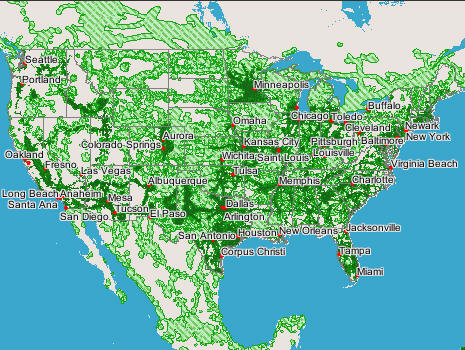 |
| T-Mobile Prepaid
Dark green is native coverage. Hatched
green is roaming coverage. Gray and white is no coverage |
|
T-Mobile
Postpaid Service
Dark green is native coverage. Hatched
green is roaming coverage. Gray and white is no coverage |
AT&T Go Phone
Note that AT&T prepaid's coverage area
is much smaller than their postpaid coverage area. Don't go to Montana, Wyoming,
South Dakota, North Dakota, Nebraska, or southern Oregon.
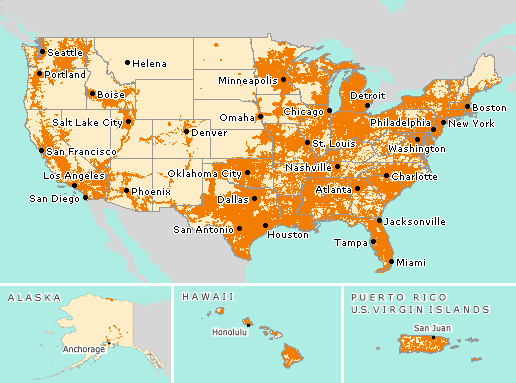 |
|
 |
| AT&T Go Phone Prepaid
Dark orange is coverage. Light orange is
no coverage. |
|
AT&T Postpaid
Service
Dark orange is coverage.
Light orange is no coverage. |
Verizon
Verizon has the same coverage for both
prepaid and postpaid, but postpaid roaming is free, while prepaid roaming is 20¢/minute.
 |
|
 |
Verizon InPulse
Prepaid
Purple is included coverage (native or roaming), gray is extra
cost roaming, white is no coverage |
|
Verizon Postpaid
Service
Red is included coverage (native or roaming), white is No
Coverage. |
Tracfone &
Net10
Tracfone offers both CDMA and GSM
phones, so you need to know your phone's technology when you check coverage. As
you can see, CDMA offers much better coverage in rural areas (there are
technological reasons for this, and as a result more rural carriers operate CDMA
networks than GSM networks). These maps don't distinguish between roaming and non-roaming areas.
For some Tracfone models you pay 2 units per minute for roaming (versus 1 unit
per minute for native coverage calls). For some Tracfone models there is no
premium for roaming. Some users have reported roaming in Canada at no extra
charge, and Tracfone getting upset about it. On a Tracfone, your account balance
is electronically loaded into the actual handset, and the carrier often doesn't
know that they should not be allowing the call to go through or that they should
be charging 2 units per minute.
Net10 is GSM only and does not charge
for roaming.











